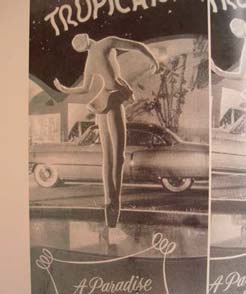Victor Correa, an experienced promoter of shows, comes to Cuba accompanied by his wife, the Spanish cupletista Teresita de España, from Panama, where she runned a cabaret. He opens the Eden Concert, a nightclub situated at Zulueta between Animas and Virtudes, in the background Hotel Sevilla, and hires the choreographers Sergio Orta, Julio Richards and Henry Bell, whose developments would lead the backing of the orchestra of the composer Alfredo Brito . Eventually certain legends and rumors about this place rose, and as was small for his promotional concerns decides to seek a broader site and meet certain requirements, such as the possibility of playing and creating larger shows.

Villa Mina was a recreation place that was in the Truffin Ave., named after the name of its owner, on the outskirts of Havana and in an area known as Marianao, west of the capital, with an area of about a cavalry covered by lush trees, whose owner, Regino Du Rapaire Truffin, Russian consul in Cuba, upon his death left it to his wife, Mrs. Mina Pérez Chaumont. This property was the place of countless parties with which their owners entertained their friends, so it was well known in society at that time; it also served as accommodation for the United States ambassador in Cuba for a few months.
The widow remarries a Roosevelt administration senator, but destiny made her widowed again and at that moment, amid the economic crisis of the late thirties, Victor Correa makes her propositions that she accepts immediately: to rent the fifth -house for a hundred pesos a month, an amount that at the time was to be considered.
Correa had the intention to build under the stars a kind of country restaurant, with lush vegetation, and have the possibility of major events and especially the installation of arcades, under the Law of the Treasury issued by President Alfredo Zayas, authorizing the game in the area of Marianao. For this purpose he initially leased the former dining room of the residence to a gambler named Rafael Makarov, represented by a colonel in the military dictatorship named Ferrer. To mount the show he was accompanied by the experienced Sergio Orta and the orchestra of Alfredo Brito.
 In December 31, 1939 was inaugurated the Boite Du Nuit, as initially Correa wanted to call it, named Beau Site, with a capacity of about three hundred people and a small game room that was liked by the audience. The original building consisted of a platform with side access and a circular dance salon. The stage appeared to be escorted by a palm on each side, apparently held a cantilevered plate singular display of balance and symmetry. The bar was far from the hall, where the show was easily appreciated, all made on the basis of the use of the reed and the exploitation of the flora of the place where the palms, including those known as "canas" highlighted.
In December 31, 1939 was inaugurated the Boite Du Nuit, as initially Correa wanted to call it, named Beau Site, with a capacity of about three hundred people and a small game room that was liked by the audience. The original building consisted of a platform with side access and a circular dance salon. The stage appeared to be escorted by a palm on each side, apparently held a cantilevered plate singular display of balance and symmetry. The bar was far from the hall, where the show was easily appreciated, all made on the basis of the use of the reed and the exploitation of the flora of the place where the palms, including those known as "canas" highlighted.
Its modern design and exquisite decoration together with its airy vegetation, identified it as an exotic and sensual place, and its furniture, built on reeds and plant fibers simulating wicker, offered a cozy country atmosphere.
In the following months Sergio Orta listened to Tropicana song, composed by Alfredo Brito at the request of Correa and recorded in the house at Calzada del Cerro no. 1269, and decided to use it as the theme of the beginning of the shows. Brito named it this way considering the tropical vegetation of the area, together with many canas palms. By joining the two words the Tropicana name was born, being renamed the cabaret with this name definitely the December 31, 1940.
n the early years the song was echoed by the orchestra with the letter of the second stanza.
The Eden Concert was closed for a very short time. Julio Burger , a Cuban son of German, reopens it with the name of Zombie Club, whose special attraction was the already popular Conjunto Casino. Its circular salon allowed the simultaneous orchestras change. Over time it became one of the favorite of Havana families. Thus arose a new nightclub which, combined with the Antillean Sport, Rumba Palace, Pennsylvania, Chaflán, Panchín, Mi Bohio, Colonial, Kurssal, La Choricera --- made world famous by Marlon Brando for his many visits --- the mighty Grand National Casino, Sans Soucci and Summer Casino de la Playa formed the most popular recreation nightspots at that time.
Related Publications

How Harumi Yamaguchi invented the modern woman in Japan
March 16, 2022
Giovanni Duarte and an orchestra capable of everything
August 26, 2020











